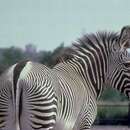Biology
(
الإنجليزية
)
المقدمة من Arkive
Grevy's zebra has a much more open society than those of other equid species and associations between individuals, other than between a mother and her foal, rarely last for more than a few months (4). Within a single population around ten percent of the mature stallions will occupy territories from which they have sole access to receptive females, although other males are still tolerated within the area (2). These territories are patrolled and marked with dung and are the largest of any living herbivore, at up to 10km2 (2). Temporary groups of between six to twenty zebras also form and may be either single sex or mixed. Mares become sexually mature at three to four years and give birth to a single foal after a gestation period of 13 months every couple of years (2). Foals are able to stand after a mere six minutes and can run after 45 minutes (6), they remain dependent on their mother's milk until six to eight months of age (2).
Grevy's zebras are predominately grazers, feeding on a variety of grasses, although they will also browse on trees and scrubs (4). Several theories exist as to the function of zebra stripes, from camouflage to the dazzling of predators. Recent research has suggested however, that they may serve a social function and may stimulate grooming (5). It is believed that the equine ancestor of horses, asses and zebras was striped, but these have subsequently been lost during the evolution of the other two groups (5).
Conservation
(
الإنجليزية
)
المقدمة من Arkive
Grevy's zebra is listed on Appendix I of the Convention on International Trade in Endangered Species (CITES), effectively banning international trade in this species (4). It is protected by law in Ethiopia and by a hunting ban in Kenya (7). This rare species also occurs in protected reserves throughout much of its current range (7), such as in Lewa Wildlife Conservancy in Kenya, which currently holds 425 individuals, representing 20 percent of the world's total population (8).
Description
(
الإنجليزية
)
المقدمة من Arkive
Grevy's zebra is the largest of the equids (a group that includes horses, asses and zebras) (4). It possesses the same body shape as other equids with a long head and neck and slender legs resting on a single digit in the form of a hoof (5). The sleek coat is patterned with black and white vertical stripes that are much narrower than those of the plains zebra (Equs burchelli) and persist until above the hind legs where a chevron pattern occurs (6). The horizontal stripes on the legs remain distinct all the way down to the hooves, and the tall, upright mane is also striped in a pattern that continues on from the neck. A wide black stripe along the back is bordered by white and is very distinctive (2). The muzzle is a tan colour with white edges, and the large, rounded ears are striped on the back (2).
Habitat
(
الإنجليزية
)
المقدمة من Arkive
Inhabits dry, semi-desert grasslands of Africa (2).
Range
(
الإنجليزية
)
المقدمة من Arkive
Previously found in central Ethiopia, Somalia and northern Kenya, but currently restricted to northeastern Ethiopia and Kenya (1) (4). The species has not been sighted in Somalia since 1973 and is therefore presumed extinct in this country (4).
Status
(
الإنجليزية
)
المقدمة من Arkive
Classified as Endangered (EN) on the IUCN Red List 2007 (1) and listed on Appendix I of CITES (3).
Threats
(
الإنجليزية
)
المقدمة من Arkive
Numbers of Grevy's zebra underwent a dramatic decline in the 1970s when the coat became prized on the international fashion circuit (4). Poaching has since declined due to effective protection measures and a lack of demand. Habitat loss is the most potent threat to the survival of the species today; grasslands are cleared to make way for agriculture and zebras also compete with domestic stock for grazing areas and water (4).

